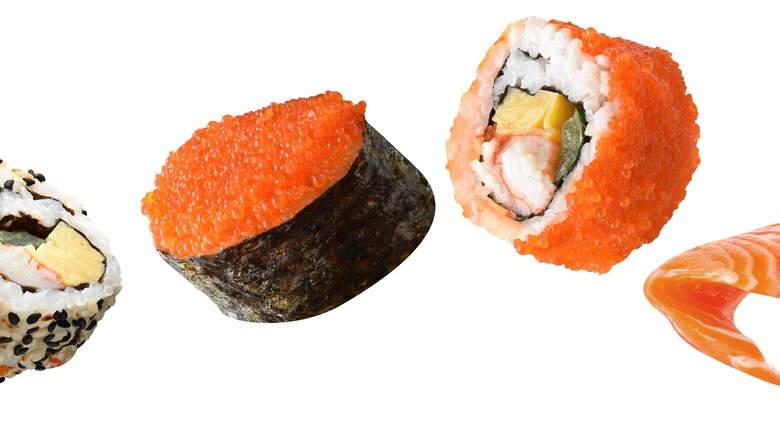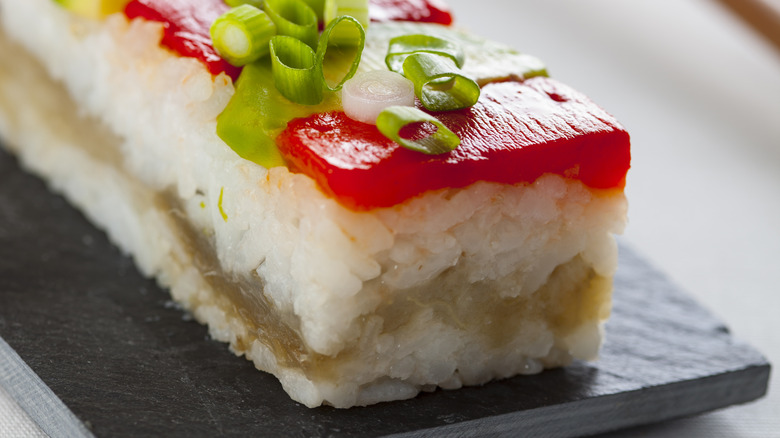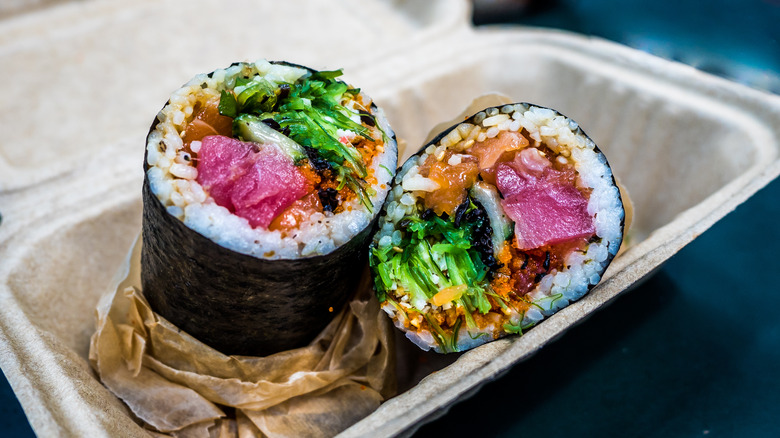The True Origin Of Sushi
Japan is known for its rich food culture, and its cuisine encompasses a wide variety of dishes worth trying, like the lesser-known takoyaki street food or Japanese pizza, okonomiyaki. Undoubtedly the country is most known for its iconic noodles — udon, ramen, soba — and, of course, sushi. The winning combination of raw fish and rice is world-famous, and in the sushi universe, there are countless ways to prepare, serve and consume raw fish: in rolls, handrolls, sashimi style, nigiri, chirashi bowls, and more.
Sushi is also immensely popular: in the United States alone, there are nearly 20,000 sushi restaurants (per Ibis World), and now it's even easy to find pre-made and pre-packaged sushi in grocery stores (though you may want to think twice before buying grocery store sushi). And while the global consciousness tends to associate sushi with Japan automatically, sushi does not come from the Land of the Rising Sun. In fact, sushi's origins lie in Southeast Asia.
Sushi has ancient Southeast Asian origins
According to South China Morning Post, rice and raw fish was a duo first put together somewhere on the Mekong River (which now runs through Thailand, Vietnam, Myanmar, Laos, and Cambodia) a long time ago, around the third century. Chef Kazunari Araki stated in an interview that river denizens subsisted on fish, and due to the hot climate, necessity forced them to find a way to preserve their sustenance. Their solution was to mix rice and salt and then use the mixture to cover gutted and cleaned fish to prevent the meat from rotting. The rice, then too salty to consume, was thrown away. Sushi was initially not eaten fresh or with rice but instead preserved.
Other historians date a slightly different practice around the same time called "nare sushi" to Southern China in regions near Lake Biwa (via Insider), in which fish — most likely carp — was gutted, stuffed with rice, pickled in a wooden barrel with salt, and then eaten a year later, without the rice. Eventually, fish preservation methods would make it to Japan during the Nara period (per JW Web Magazine).
The evolution of sushi in Japan
By the 14th century in Japan, han-nare was the next step in the evolution of sushi. Instead of waiting a year to eat the preserved fish, impatient appetites cracked open the wooden barrels just one month after preservation. At this moment, the rice started to get consumed instead of thrown aside, and a taste for vinegared or slightly sour rice began to develop, per Insider.
In the following four centuries, haya-nare sushi began to develop, and the "box-pressed cured fish over vinegar-seasoned rice" was the next precursor of modern sushi as we know it today. However, the lead time before eating was still a couple of days. The next step in sushi evolution took place during the Edo period in Tokyo: busy workers needed a fast lunch because of frequent fires that plagued the city. The solution: quickly cured fish from the bay, paired with vinegared rice.
The Edo period of sushi and beyond
As reported by JW Web Magazine, during the Edo period, nigiri sushi first emerged, which consisted of raw or cooked fish on top of lightly compressed sushi rice, first sold by Hanaya Yohei, who opened a stall in 1824 in Tokyo's Ryogoku district. Soon after, other varieties of sushi came onto the scene: hand-rolled sushi (maki-zushi) and vinegared rice-stuffed tofu pockets (inari-zushi). By 1923, there were hundreds of sushi carts around the capital, but when a giant earthquake of that year caused land prices to decrease, sushi vendors began to set up permanent shops (per PBS).
When refrigeration technology made significant advances in the 1970s, sushi popularity and availability exploded, and the first sushi shop in the United States opened in Los Angeles in 1966, even though sushi may have made it to America as early as 1904 at a socialite's dinner, according to the Michelin Guide. Since then, sushi innovation has continued, with bizarre creations like the sushirrito (sushi in the form of a burrito), to cheeseburger sushi (a cheeseburger in the form of a sushi roll) per Condé Nast Traveller.



